牛津版 第17讲 分词用法详解
- 格式:docx
- 大小:443.52 KB
- 文档页数:19
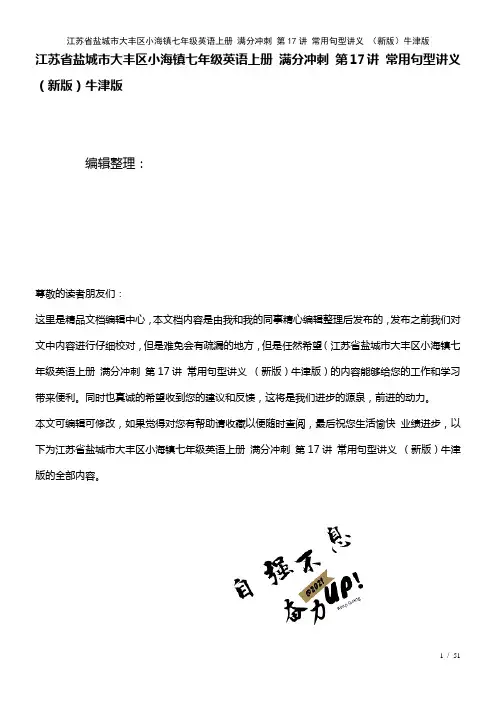
江苏省盐城市大丰区小海镇七年级英语上册满分冲刺第17讲常用句型讲义(新版)牛津版编辑整理:尊敬的读者朋友们:这里是精品文档编辑中心,本文档内容是由我和我的同事精心编辑整理后发布的,发布之前我们对文中内容进行仔细校对,但是难免会有疏漏的地方,但是任然希望(江苏省盐城市大丰区小海镇七年级英语上册满分冲刺第17讲常用句型讲义(新版)牛津版)的内容能够给您的工作和学习带来便利。
同时也真诚的希望收到您的建议和反馈,这将是我们进步的源泉,前进的动力。
本文可编辑可修改,如果觉得对您有帮助请收藏以便随时查阅,最后祝您生活愉快业绩进步,以下为江苏省盐城市大丰区小海镇七年级英语上册满分冲刺第17讲常用句型讲义(新版)牛津版的全部内容。
第17讲常用句型题一:sb。
like(s)…/ enjoy(s)…/ love(s)…我喜欢游泳.________________________________.题二:sb’s favourite … is/are…我的朋友们特别喜欢野餐。
________________________________。
题三:sb。
be interested in…sb。
is fond of…我喜欢各种各样的花.______________________________。
题四:sb。
be excited about…你应该为自己的成功感到兴奋。
_________________________________.题五:sb. be good at…/sb。
do(es)well in…我爸爸对汽车感兴趣并且他擅长修车。
_______________________________.题六:sb。
always give(s) a helping hand to people in trouble.他是一个乐于助人的人,从不吝惜于伸出援手去帮助有需要的人。
_____________________________________.题七:sb. like(s) making friends and get(s) on well with others. 她外向的性格让她乐于交友并且擅长与人相处。
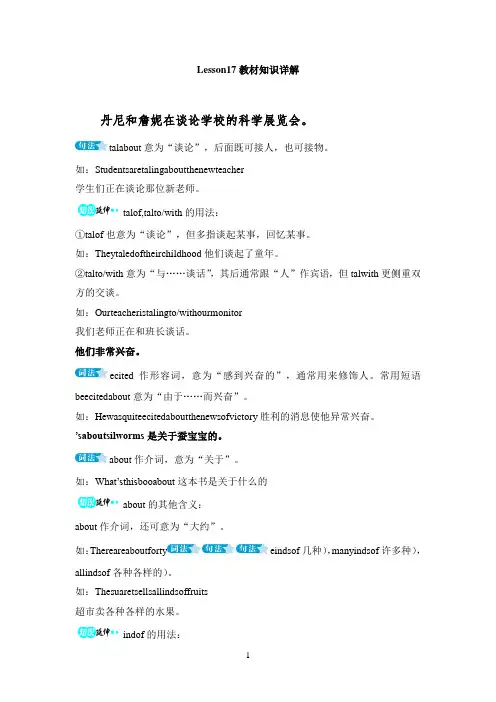
Lesson17教材知识详解丹尼和詹妮在谈论学校的科学展览会。
talabout意为“谈论”,后面既可接人,也可接物。
如:Studentsaretalingaboutthenewteacher学生们正在谈论那位新老师。
talof,talto/with的用法:①talof也意为“谈论”,但多指谈起某事,回忆某事。
如:Theytaledoftheirchildhood他们谈起了童年。
②talto/with意为“与……谈话”,其后通常跟“人”作宾语,但talwith更侧重双方的交谈。
如:Ourteacheristalingto/withourmonitor我们老师正在和班长谈话。
他们非常兴奋。
ecited作形容词,意为“感到兴奋的”,通常用来修饰人。
常用短语beecitedabout意为“由于……而兴奋”。
如:Hewasquiteecitedaboutthenewsofvictory胜利的消息使他异常兴奋。
’saboutsilworms是关于蚕宝宝的。
about作介词,意为“关于”。
如:What’sthisbooabout这本书是关于什么的about的其他含义:about作介词,还可意为“大约”。
如:Thereareaboutforty eindsof几种),manyindsof许多种),allindsof各种各样的)。
如:Thesuaretsellsallindsoffruits超市卖各种各样的水果。
indof的用法:indof意为“有点儿;有几分”,用于修饰形容词或副词,表示程度,多用于口语中。
同义短语为alittle,abit,alittlebit。
I’mindofhungry我有点儿饿了。
Sheloosindofpaleafterherillness她生病后面色有点苍白。
而且人们都可以品尝。
all作形容词,意为“所有的,整个的”,修饰可数名词复数或不可数名词。
其位置须放在定冠词the、指示代词或物主代词之前,即“allthe/指示代词/物主代词名词”。
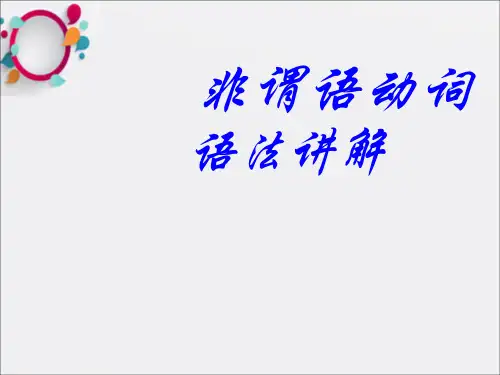
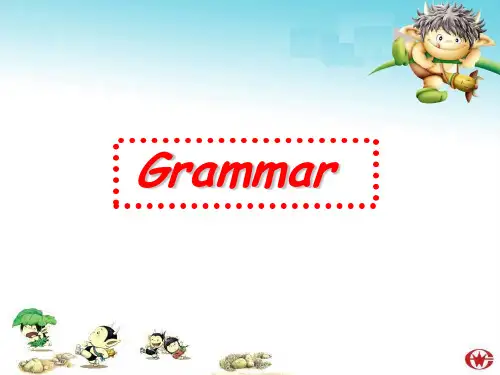
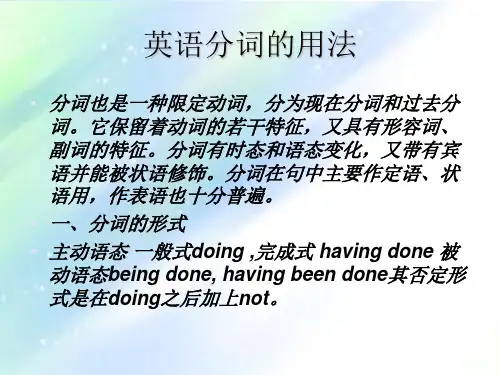
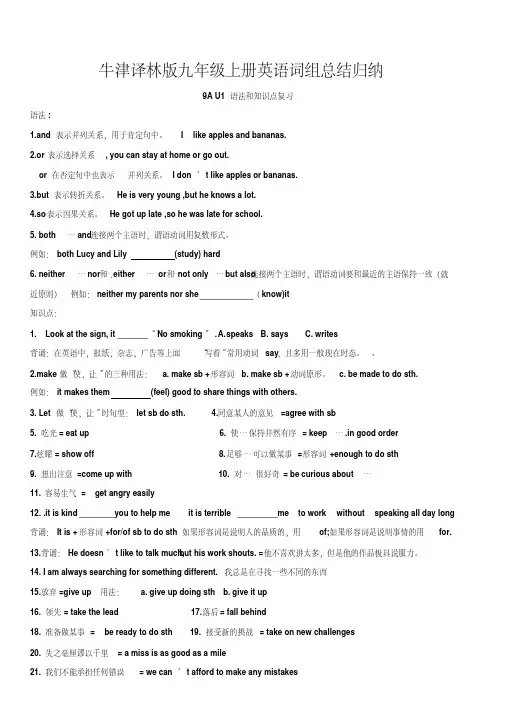
牛津译林版九年级上册英语词组总结归纳9A U1 语法和知识点复习语法:1.and 表示并列关系,用于肯定句中。
I like apples and bananas.2.or表示选择关系, you can stay at home or go out.or 在否定句中也表示并列关系。
I don’t like apples or bananas.3.but 表示转折关系。
He is very young ,but he knows a lot.4.so表示因果关系。
He got up late ,so he was late for school.5. both …and…连接两个主语时,谓语动词用复数形式。
例如:both Lucy and Lily (study) hard和not only…but also连接两个主语时,谓语动词要和最近的主语保持一致(就6. neither…nor….和either … or…近原则)例如:neither my parents nor she (know)it知识点:1.Look at the sign, it “No smoking”. A.speaks B. says C. writes背诵:在英语中,报纸,杂志,广告等上面“写着”常用动词say,且多用一般现在时态。
、2.make做“使,让”的三种用法: a. make sb +形容词 b. make sb +动词原形。
c. be made to do sth.例如:it makes them (feel) good to share things with others.3. Let 做“使,让”时句型:let sb do sth.4.同意某人的意见=agree with sb5. 吃光= eat up6. 使…保持井然有序= keep ….in good order7.炫耀= show off 8.足够…可以做某事=形容词+enough to do sth9. 想出注意=come up with 10. 对… 很好奇= be curious about…11. 容易生气= get angry easily12. .it is kind you to help me it is terrible me to work without speaking all day long 背诵:It is +形容词+for/of sb to do sth 如果形容词是说明人的品质的,用of;如果形容词是说明事情的用for.13.背诵:He doesn’t like to talk much, but his work shouts. =他不喜欢讲太多,但是他的作品极具说服力。
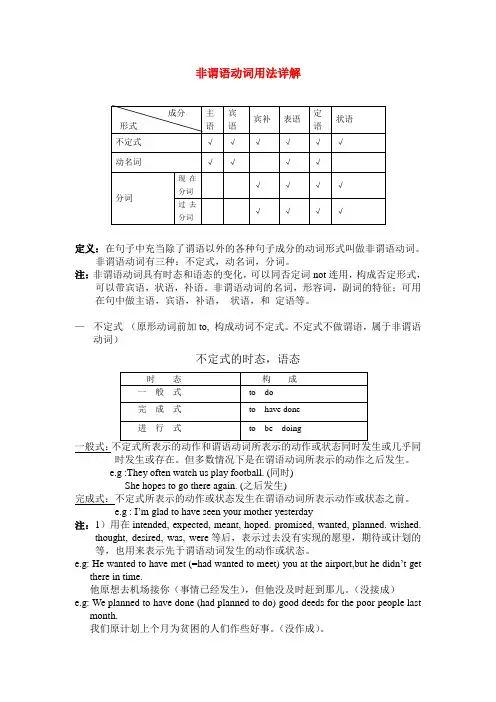
非谓语动词用法详解定义:在句子中充当除了谓语以外的各种句子成分的动词形式叫做非谓语动词。
非谓语动词有三种:不定式,动名词,分词。
注:非谓语动词具有时态和语态的变化,可以同否定词not连用,构成否定形式,可以带宾语,状语,补语。
非谓语动词的名词,形容词,副词的特征;可用在句中做主语,宾语,补语,状语,和定语等。
—不定式(原形动词前加to, 构成动词不定式。
不定式不做谓语,属于非谓语动词)不定式的时态,语态一般式:不定式所表示的动作和谓语动词所表示的动作或状态同时发生或几乎同时发生或存在。
但多数情况下是在谓语动词所表示的动作之后发生。
e.g :They often watch us play football. (同时)She hopes to go there again. (之后发生)完成式:不定式所表示的动作或状态发生在谓语动词所表示动作或状态之前。
e.g : I’m glad to have seen your mother yesterday注:1)用在intended, expected, meant, hoped. promised, wanted, planned. wished.thought, desired, was, were等后,表示过去没有实现的愿望,期待或计划的等,也用来表示先于谓语动词发生的动作或状态。
e.g: He wanted to have met (=had wanted to meet) you at the airport,but he didn’t getthere in time.他原想去机场接你(事情已经发生),但他没及时赶到那儿。
(没接成)e.g: We planned to have done (had planned to do) good deeds for the poor people lastmonth.我们原计划上个月为贫困的人们作些好事。
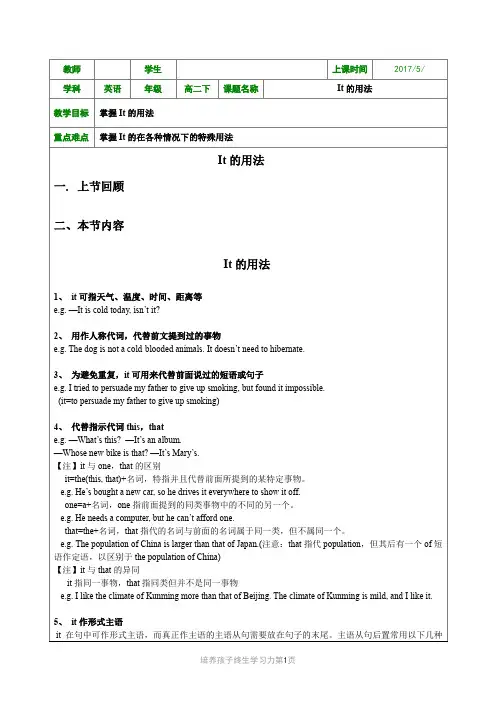
这个句型中,it指时间,而且表示时间的词语前没有介词(时间一般是具体时间)。
主句和从句中的谓语动词在时态上是一致的,主句是will be,when从句用一般现在时代替将来时。
e.g. It was already 8 o’clock when we got home.It will be late afternoon when they get there.4)It be +时间+ that-clause这个句型是个强调句型。
e.g. It was at 5 o’clock that he practiced playing the violin in the morning.(原句是:He practiced playing the violin at 5 o’clock in the morning.)比较:It was 5 o’clock when he started in the morning.(5 o’clock前没有介词,这个是定语从句)5)It be + time + that-clause这个句型属虚拟语气结构,不管主句中用的是is或was,that从句都须用动词的过去式或should+动词原形(但不及物动词通常用过去式),在time之前有时可以加上high或about以加强语气。
e.g. It is high time (that) he wrote a letter to his girlfriend.It is time (that) we made people’s life a little easier. = It is time that we should make people’s life a little easier.9、It/This/That + be + the first(second, third…) time + that-clause这个句型表示截止到说话时为止的某人的一种经历,关键是注意time前有序数词,主句是一般现在时is时,从句要用现在完成时;如果主句用一般过去时was时,则从句须相应地用过去完成时。
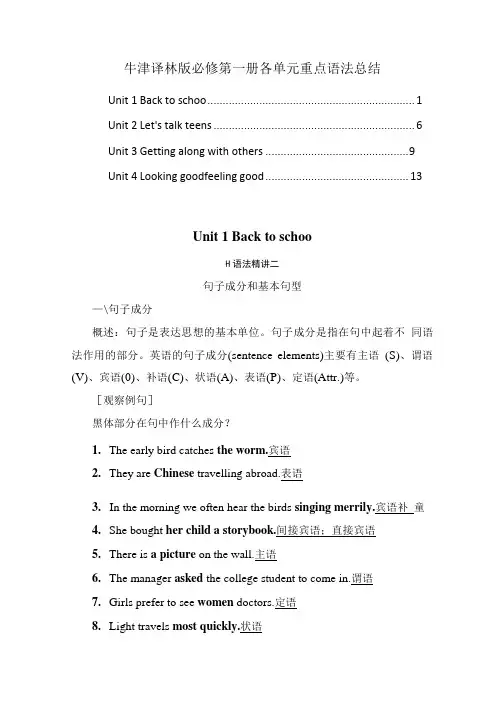
牛津译林版必修第一册各单元重点语法总结Unit 1 Back to schoo (1)Unit 2 Let's talk teens (6)Unit 3 Getting along with others (9)Unit 4 Looking goodfeeling good (13)Unit 1 Back to schooH语法精讲二句子成分和基本句型—\句子成分概述:句子是表达思想的基本单位。
句子成分是指在句中起着不同语法作用的部分。
英语的句子成分(sentence elements)主要有主语(S)、谓语(V)、宾语(0)、补语(C)、状语(A)、表语(P)、定语(Attr.)等。
[观察例句]黑体部分在句中作什么成分?1.The early bird catches the worm.宾语2.They are Chinese travelling abroad.表语3.In the morning we often hear the birds singing merrily.宾语补童4.She bought her child a storybook.间接宾语;直接宾语5.There is a picture on the wall.主语6.The manager asked the college student to come in.谓语7.Girls prefer to see women doctors.定语8.Light travels most quickly.状语[归纳用法]1.主语(subject):指句子所谈论的主体,通常是某人、某事或某物。
We work five days a week.我们一周工作五天。
To persuade her to change her mind is really very hard.说服她改变主意确实很难。
2.谓语(verb):指谓语部分的主要动词,另外,主要动词前的情态动词和助动词也被视为谓语的组成部分,通常说明主语发出的动作或主语的特征和状态。
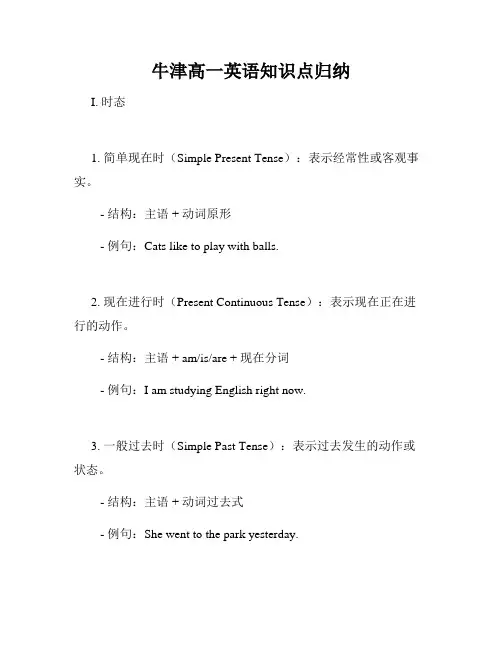
牛津高一英语知识点归纳I. 时态1. 简单现在时(Simple Present Tense):表示经常性或客观事实。
- 结构:主语 + 动词原形- 例句:Cats like to play with balls.2. 现在进行时(Present Continuous Tense):表示现在正在进行的动作。
- 结构:主语 + am/is/are + 现在分词- 例句:I am studying English right now.3. 一般过去时(Simple Past Tense):表示过去发生的动作或状态。
- 结构:主语 + 动词过去式- 例句:She went to the park yesterday.4. 过去进行时(Past Continuous Tense):表示过去某个时间正在进行的动作。
- 结构:主语 + was/were + 现在分词- 例句:We were playing basketball at 5 p.m. yesterday.5. 将来时态(Future Tenses):表示将来将要发生的动作。
- 一般将来时(Simple Future Tense):结构:主语 + will + 动词原形例句:They will arrive tomorrow.- 进行时态(Future Continuous Tense):结构:主语 + will be + 现在分词例句:I will be studying when you come.II. 被动语态1. 一般现在时的被动语态(Simple Present Passive):表示主语是动作的接受者。
- 结构:主语 + am/is/are + 被动语态- 例句:The book is read by many people.2. 一般过去式的被动语态(Simple Past Passive):表示过去某个动作的接受者。
- 结构:主语 + was/were + 被动语态- 例句:The car was driven by my father yesterday.3. 情态动词的被动语态(Modal Verbs in Passive):表示对于某种动作的可能性或能力。
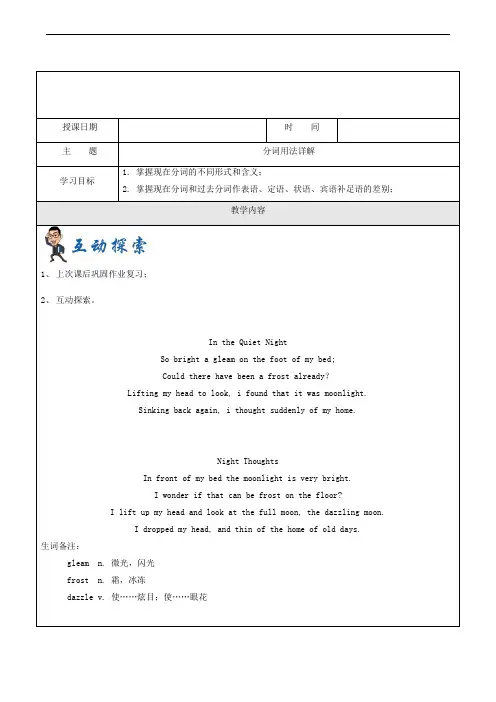
授课日期时间主题分词用法详解学习目标1. 掌握现在分词的不同形式和含义;2. 掌握现在分词和过去分词作表语、定语、状语、宾语补足语的差别;教学内容1、上次课后巩固作业复习;2、互动探索。
In the Quiet NightSo bright a gleam on the foot of my bed;Could there have been a frost already?Lifting my head to look, i found that it was moonlight.Sinking back again, i thought suddenly of my home.Night ThoughtsIn front of my bed the moonlight is very bright.I wonder if that can be frost on the floor?I lift up my head and look at the full moon, the dazzling moon.I dropped my head, and thin of the home of old days.生词备注:gleam n. 微光,闪光frost n. 霜,冰冻dazzle v. 使……炫目;使……眼花现在分词和过去分词的用法【知识梳理1】现在分词的四种形式现在分词除了一般式之外,还有完成式和被动式,以动词do为例,现在分词的四种形式见下表:doing being donehaving done having been done1) doing:主动/进行eg. a)I hear someone singing an English song in the next room.Last night, I heard someone singing an English song in the next room.b) The man standing on the platform is waving his hand to us.c) They stood by the roadside, begging.doing所表示的动作与谓语动词同时发生,与逻辑主语是主动关系。
主语从句复习句子成分二、主语的作用主语是谓语讲述的对象,表示所说的“是什么”或“是谁”。
一般由名词、代词、不定代词或相当于名词的单词或短语来充当,也有从句充当的现象。
大多数主语都在句首。
如:讲述“谁”:We work in a big factory.讲述“什么”:The classroom is very big.数词作主语:Three are enough. 三个人就够了不定式作主语:To operate on the blind is one of the ORBIS Doctor’s job.▲ 在“There be …”句型中,主语的位置在中间。
如:There are some bottles of milk in the box.▲ 在个别句型中,主语在整个句子后面,这时前面用it作形式主语。
如:It is very interesting to play the game called “treat or trick”.It took two workers about three months to build the house.从句作主语:What we need is food. 我们最需要的是食物.三. 主语从句在复合句中起主语作用的从句叫主语从句。
引导主语从句的关联词有从属连词that、whether,关系代词:who, what, which , whom, whose, whatever, whoever, whomever, whichever;关系副词:when, where, how, why, however, whenever, wherever等。
在上海高考中的主语从句,新题型中注重连接词的选用,翻译中注重考查句子结构。
知识梳理第一部分:常规主语从句,即句子在复合句中充当一个主语主语从句的时态:不受主句的时态影响和限制。
(1)That he finished writing the composition in such a short time surprised us all.(2)Whether we will go for an outing tomorrow remains unknown.(3)Who will be our monitor hasn't been decided yet.(4)Whom we must study for is a question of great importance.(5)What caused the accident remains unknown.(6)Whatever you did is right.(7)Who the watch belongs to was lost is unknown.(8)What we need is time.(9)What we need are good doctors.小结:(1)引导主语从句连词有that,whether,who,what,whatever等(2)连词位于句首不能省略(3)主语从句大多数情况下视为三单,但也有例外,如例9专项练习A. What... whyB. That. . . whatC. What.. . becauseD. Why.. .thatA. whileB. thatC. ifD. for3.It is pretty well understood controls the flow of carbon dioxide in and out the atmosphere today.A. thatB. whenC. whatD. how4. ______ man first made use of electricity is not exactly known.A. WhenB. IfC. ThatD. What5. ______ we will have a meeting hasn't been decided yet.A. IfB. ThatC. WhatD.WhetherA. That... thatB. What... whatC. Whatever.. . thatD. As... as7. ______ leaves last turns off the light.A. WhoB. WhoeverC. No matter whoD.Whomever8. ______ wins the prize may get the car.A. WhoB. WhomC. WhomeverD.Whoever9. ______ a pity that I didn't see you last week.A. That'sB. What'sC. It'sD. There's10. ________ s he will come is certain.A. ThatB. WhatC. /D.WhetherA. If... doB. That... doC. That... doesD. If...does12. _______ h as questions can ask the teacher after class.A. WhoB. WhoeverC. AnybodyD. One13. is one of the most useful and fascinating divisions of human knowledge is widely accepted.A. Where chemistryB. That chemistryC. What chemistryD. ChemistryA. whyB. thatC. whetherD. how15.Does _________ matter if he can't finish the job on time?A. thisB. thatC. heD. itA. That... producingB. That... produceC. This... producingD. This... produces17.After Yang Liwei succeeded in circling the earth, our astronauts desire to do is to walk in space.A. whereB. whatC. thatD. how18.It is doubtful_________he knows it or not.A. thatB. ifC. whatD.whether19. _______ caused the accident is still a complete mystery.A. WhatB. ThatC. HowD. Where20. ______ they will hold a sports meeting next week hasn't been decided yet.A. IfB. ThatC. WhatD.Whether21.It doesn't matter_______ will take charge of the work.A. whoB. whoeverC. whomD.whomever22.______ is worth doing at all is worth doing well.A. ThatB. WhichC. WhateverD. ItA. What... isB. Whether. .. areC. That... isD. If... is24. _______ some mammals came to live in the sea is not known.A. ThatB. SinceC. AlthoughD. HowA. That... whether... /B. What... if... thatC. That... if... whatD. What. .. whether... /Keys: 1-5 ABCAD 6-10 BBDCA 11-15 CBBBD 16-20 BBDAD 21-25 ACCDD第二部分it作形式主语引导主语从句如果主语从句太长,为避免句子结构头重脚轻,我们可用it作形式主语,而把主语从句放在主句谓语部分之后。
授课日期时间 A / B / C / D / E / F段主题主谓一致用法总结学习目标1.主谓一致知识点梳理和总结概括;2.主谓一致与其他语法的结合;教学内容1、上次课后巩固作业复习;2、互动探索教学建议:通过改错,让学生找出共同点,并且直接过渡到主谓一致的学习。
改错:1. Her clothes is nearly worn out.2. Her family is all sports lovers.3. She spends most of her times in science researches.4. About 70 percent of the surface of our planet are covered by water.5. Either Bill or John want the football tickets for tomorrow.Key: 1 is 改成are 2 is 改成are 3 times改成time 4 are改成is 5 want改成wants(此部分测试时间为20分钟左右,讲评时间为15分钟左右。
)建议步骤:1)在10分钟内学员独立完成测试;2)老师给出答案,学员相互批改;3)在5分钟内就错题学员间相互合作,讨论错题,保证每一位学员都懂;4)老师随机抽查,根据学生的整体表现给出此部分的班级得分(评分标准参考课堂激励评分标准)(基础题)1. According to a survey, the number of Chinese weibo users ________ (reach) 250 million so farthis year, making China the world's No. 1 weibo-using country.2. World Wildlife Fund's project Earth Hour, which encourages people to turn off the light foran hour on the last Saturday of every March, ________ (carry out) to help to create a promising future for the planet.3 Did you foresee that so many investors ______ (lose) all their money in the stock market?4. All the residents in the area ______ (advise) that they move into new flats within three months.5. Since the 14th and 15th centuries, the Diaoyu Islands _____ (include) in Chinese maps.6. The low-budget film Lost in Thailand just __________ (become) the most bankable Chinese filmof all time.7. ---I don’t think our coach knows the real reason for our losing the match.---Well, surprisingly, he does. Our team leader has been called in and (question) now.8. Dr. Margaret Chan was eventually selected as the world's top health official and it is the firsttime that a Chinese ________(hold) such a high-ranking U.N. post.9. More than 20 cars of the new type _____ (sell) in the first three days after its launch lastSaturday.10. – Mike, did you see Mr. Chapman in the office just now?-- Yes, he ______(interview), and he looked a little bit nervous.与其他工业国家一样,英国在过去的一百年里发生了巨大的变化。
M1U1 This is me!内容要点:学习带有be动词的一般现在时基本要求:掌握基本词汇与短语熟识be动词一般现在时用法重难点:be动词一般现在时的用法知识点解读1. read books 读/看书2. look after 照顾We love looking after the children. = We love taking care of the children.我们喜爱照顾孩子。
3. make friends (with sb.) 与某人交朋友Teachers should try to make friends with their friends.老师应该试着与学生交朋友。
4. the first day 第一天5. introduce oneself to sb. 向某人作自我介绍6. love/like/enjoy doing sth. 喜爱做某事I love/like/enjoy playing football. 我喜欢踢足球。
7. be from = come from 来自...He is from Nanjing. = He comes from Nanjing.他来自南京。
8. work hard 努力学习We should work hard.我们应当努力学习。
9. be good at = do well in = be clever at 擅长于... 在...方面做得好Boys are good at science. = Boys do well in science. = Boys are clever at science 男孩子们擅长科学。
10. wear glasses 戴眼镜【区别】wear与put onwear 穿,戴,强调状态,“穿(戴)着...”put on 穿,戴,强调过程,“穿(戴)上”重点语法:带有be动词的一般现在时1.一般现在时陈述句第一人称单数:I (我) I am a student. I am 13 years old. → I’m第一人称复数:We (我们) We are students. →We’re第二人称单数:You(你) You are a student. →You’re第二人称复数:You(你们) You are students.第三人生单数:He(他) He is a good boy. →He’sShe(她) She is happy. →She’sIt(它) It is cold outside. →It’s第三人称复数:They(他们) They are very young. →They’re2.一般疑问句只需要把be动词提到主语前面。
课时17. 9B Unit 1-2高频考点突破一.pride n. 骄傲,可引以自豪的人(或事物)的人是谁?日,阿姆斯特朗成为第一个登上月球的人。
不能生存。
随堂练习一1.The man won a talent show called The Sound because of his excellent voice and________(wonder) acting skills.2.How should I arrange my schedule? Can you give me some ________(science) advice?3.I ________(know) her for twenty years.4.We are very ________(pride) that a student from our school has won the first prize.5.Mr. Smith's biggest ________(advantage) is that he is a forgetful person.6.With the ________(develop) of the science and technology, more and more people can pay the money by mobile phone.7.Could you please tell us about the four great ________(invent) of China?8.The well-known restaurant will ________(service) 10 new dishes next month.9.My sister can speak Chinese, English and ________(Japan).10.National flags are ________(hang) along the streets during the National Day.二、词汇运用1. The visitors went to Tian’anmen Square to see the ________ (raise) of the national flag.2. I’m attracted by the _________ (beautiful) of the Summer Palace.3. My favourite ___________ (attract) is the Great Wall.4. I have fun _________ (cycle) around Yandu Park beside our school.5. We learned the differences between _________ (east) and western culture.6. The Great Wall is one of the (wonderful) in the world.7. The Palace Museum is well worth_______ (visit).8. He asked me if I knew something about Japanese _________(文化).9. China has the largest _________(人口) in the world.10. Miss Thompson will take her students to visit the Tokyo __________(国家的)Museum.三、翻译句子1.很多游客喜欢一大早聚集在那里观看升旗仪式。
英语语法(牛津版)第二十六章分词272 现在(或称主动)分词A 形式动词原形+ ing:working loving sittingB 用法1 构成进行时态(参见第164节与第178节等):He is working.他正在工作。
Youve been dreaming.你一直在做梦。
2 用做形容词(参见第17节):running water自来水floating wreckage 漂浮着的残骸dripping taps滴着水的水龙头leaking pipes漏水的管道这里名词和分词都要重读。
请与在动名词+ 名词结构中重读的情况比较。
(参见第16节。
)3 位于have+ 宾语之后(参见第121节):He had me swimming in a week.他一个星期就教会我游泳了。
We have people standing on our steps all day.我们的台阶上整天站着人。
I wont have him cleaning his bike in the kitchen.我不能让他在厨房里擦洗他的自行车。
4 有时用来代替关系代词+ 动词(参见第77节):a map that marks/marked political boundaries=a map marking politicalboundaries一张标明行政疆域的地图people who wish/wished to visit the caves= people wishing to visit thecaves希望去参观岩洞的人们children who need/needed medical attention= children needing medicalattention需要医疗护理的孩子们5 用来构成现在分词/分词短语(如adding/pointing out/remind-ing/warning等)可以用在间接引语中引入陈述句:He told me to start early,reminding me that the roads would be crowded.他让我早点动身,提醒我说晚了路上会拥挤。
授课日期时间主题分词用法详解学习目标1. 掌握现在分词的不同形式和含义;2. 掌握现在分词和过去分词作表语、定语、状语、宾语补足语的差别;教学内容1、上次课后巩固作业复习;2、互动探索。
教学建议:1. 此环节设计时间在15分钟。
2. 下面是李白-静夜思的两种翻译版本,对比他们在表达上有什么不一样的地方?3. 通过让学生对比讨论,关注两种版本在表达上的不同,引出本次课的主题,分词的运用。
4. 译文如下:In the Quiet NightSo bright a gleam on the foot of my bed;Could there have been a frost already?Lifting my head to look, i found that it was moonlight.Sinking back again, i thought suddenly of my home.Night ThoughtsIn front of my bed the moonlight is very bright.I wonder if that can be frost on the floor?I lift up my head and look at the full moon, the dazzling moon.I dropped my head, and thin of the home of old days.生词备注:gleam n. 微光,闪光frost n. 霜,冰冻dazzle v. 使……炫目;使……眼花现在分词和过去分词的用法【知识梳理1】现在分词的四种形式现在分词除了一般式之外,还有完成式和被动式,以动词do为例,现在分词的四种形式见下表:doing being donehaving done having been done1) doing:主动/进行eg. a)I hear someone singing an English song in the next room.Last night, I heard someone singing an English song in the next room.b) The man standing on the platform is waving his hand to us.c) They stood by the roadside, begging.doing所表示的动作与谓语动词同时发生,与逻辑主语是主动关系。
2) being done:被动/进行eg. The problem being discussed is very important.The museum being built there will be open to the public next year.being done所表示的动作与谓语动词同时发生,但与逻辑主语是被动关系。
3) having done:主动/完成eg. Having done his homework, Tim played chess with his friends.Having cleaned the classroom, I went home.having done所表示的动作发生在谓语动词之前,与逻辑主语是主动关系。
4) having been done:被动/完成eg. Having been surrounded by the flood for over a week, the villagers lacked food and medicine.Having been shown the library, the visitors were led to the audio-visual lab.having been done所表示的动作发生在谓语动词之前,与逻辑主语是被动关系。
现在分词doing (主动/进行)being done (被动/进行)5.比利大量的闲暇时间都花在集邮上,在他的收藏品中增添新的邮票。
(spend, add)6.因为有一座桥与大陆连接,那个岛屿很容易去。
(join)7.每个运动员都刻苦训练,希望在奥运会上获奖牌。
(hope)8.听到这个骇人的消息,他的眼睛睁得很大。
(On hearing…)9.时间允许的话,我会把你昨天布置给我的任务先完成。
(独立主格结构)10.Mike在他屋子外的大街上发现了他丢失的汽车,看上去刚擦得干干净净,还打过腊。
(look)Keys:1.Being alone at home, she felt so frightened that she had the lights burning all the night.2.Not knowing his phone number, I can’t get in to uch with him.3.When I caught the shop owner cheating me, I went out of the shop at once.4.Seeing Grandma a little sleepy, he drew the curtains and turned the TV down5.Billy spends a lot of leisure hours collecting stamps, adding new ones to his collection.6.The island, joined to the mainland by a bridge, is easy to go to.7.Every one of the athletes is training hard, hoping to win medals in the Olympics.8.On hearing the shocking news, he opened his eyes wide.9.Time permitting, I will firstly finish the task you assigned yesterday.10.Mike found his missing car in the street outside his house, looking newly cleaned and polished.此环节教案预期时间20(练题)+15(互动讲解)分钟。
1.Dressed in a long black-tailed coat, he appeared on the stage like a real conductor.2.Established in the 1950s, our company enjoyed a good reputation for its quality products andafter-sale service.3.Hearing someone walking by/past the window deep at night, he covered himself with the quiltin fright.4.Being left-handed is just the way of behavio r that some people were born with, so we mustn’tlook down on them.5.Suffering from the anxiety of the examinations, he decided to seek the aid of a psychologist.6.Being two days short, we had to finish /complete the task later than planned.7.Judging from the wrinkles in the face of the white-haired old man, he has suffered a lot inhis life.8.Watching the national flag being raised, the athletes were so excited that tears came into their9.If the government left the factory polluting the river, there would be no fish here.10.Having been married for fifty years, they still love each other deeply.教学建议:1、老师引导学生针对达标检测错题进行反思和总结;2、老师引导学生对精讲提升相关知识进行总结,可采用表格、思维导图等形式呈现。
1、现在分词有形式上的变化;现在及物动词 write 不及物动词go分词主动语态被动语态主动语态一般式writing being written going完成式having written having been written having gone否定式:not + 现在分词(1)现在分词的主动语态:现在分词主动语态的一般式表示与谓语动词所表示的动作同时发生;完成式表示的动作在谓语动词所表示的动作之前发生,常作状语。
2、分词可以充当表语、宾语补足语、定语和状语。
在be、seem、remain等词后面是表语,--ing一般理解为主动或译为“令人……”常用(doing、done)在keep、find、see、make等词后面会出现分词作宾语补足语的情况,要关注和宾语之间的主被动;常用(doing、done)作为定语,单个的词会出现在名词之前,短语的形式一般出现在名词之后,要关注和被修饰的名词之间的主被动,常用(doing、done、being done)作为状语,要关注和句子主语之间的主被动以及动作的先后关系,常用(doing、done、having done、having been done)独立主格结构可以看作是主语+分词的形式,常考的有with 结构教学建议:1. 规定学生在20分钟内完成;2. 要求学生对不确定有疑问的题目做标记;3.下节新课前让学生相互批改表扬正确率最高的学生;4.让作对的学生给做错的学生讲题,老师进行补充;5.老师对错误率较高的题目相关的知识点进行复习。
基础题:1.——Which book on earth is the one you want?——There are a large number of reference books (choose) from, but I’m at a loss which to buy.2.It is believed that such measures, once(take), will surely prevent the top infectious diseasesfrom further spreading in Beijing.教学建议:让学生阅读下面的文章,思考文章后面的三个问题。